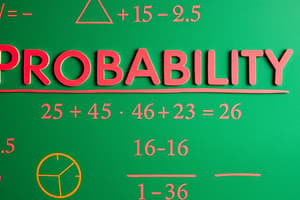Podcast
Questions and Answers
What is the firm's expected EPS?
What is the firm's expected EPS?
- $3.29. (correct)
- $5.95.
- $2.75.
This is an example of a:
This is an example of a:
- conditional expectation. (correct)
- use of Bayes' formula.
- joint probability.
Given the new information that the technology sector will not outperform the market, the probability that the economy will not expand is closest to:
Given the new information that the technology sector will not outperform the market, the probability that the economy will not expand is closest to:
- 67%. (correct)
- 54%.
- 33%.
Using Bayes' formula, what is the probability of (A | B)?
Using Bayes' formula, what is the probability of (A | B)?
What is the expected return on this investment?
What is the expected return on this investment?
What is the expected value of the prize on a single coin toss?
What is the expected value of the prize on a single coin toss?
What is the probability that the car is red given that it has a radio?
What is the probability that the car is red given that it has a radio?
Based on Bayes' theorem, the updated probability that the company will experience a decline is:
Based on Bayes' theorem, the updated probability that the company will experience a decline is:
What is the probability that it was a B-rated bond if a randomly selected bond defaults in a five-year period?
What is the probability that it was a B-rated bond if a randomly selected bond defaults in a five-year period?
What are the mean expected return and the standard deviation of expected returns, respectively?
What are the mean expected return and the standard deviation of expected returns, respectively?
What is the expected return on Portfolio A?
What is the expected return on Portfolio A?
Based on the tree diagram, the expected value of the stock if the market decreases is closest to:
Based on the tree diagram, the expected value of the stock if the market decreases is closest to:
If a randomly chosen stock is a good one, what is the probability John selected it?
If a randomly chosen stock is a good one, what is the probability John selected it?
A conditional expectation involves:
A conditional expectation involves:
Use the following data to calculate the standard deviation of the return:
Use the following data to calculate the standard deviation of the return:
Flashcards
What is Expected Value?
What is Expected Value?
The sum of each possible outcome multiplied by its probability of occurrence.
What is Conditional Expectation?
What is Conditional Expectation?
This indicates how an expected value will change given another event.
What is Bayes' Formula?
What is Bayes' Formula?
A formula for updating prior probabilities based on new information.
What is Standard Deviation?
What is Standard Deviation?
Signup and view all the flashcards
What is Covariance?
What is Covariance?
Signup and view all the flashcards
What is Correlation?
What is Correlation?
Signup and view all the flashcards
What is Conditional Probability?
What is Conditional Probability?
Signup and view all the flashcards
Study Notes
Expected EPS of XYZ Incorporated
- Scenario: 60% chance economy is good, 40% chance it is bad
- If economy is good: 70% chance of $5.00 EPS, 30% chance of $3.50 EPS for XYZ
- If economy is bad: 80% chance of $1.50 EPS, 20% chance of $1.00 EPS for XYZ
- Expected EPS is the sum of (Joint Probability x EPS) = $3.29
Conditional Expectation
- An analyst increasing the discount rate next quarter doubling their earnings forecast is an example.
- Conditional expectation is how an expected value will change given another event.
Probability & the Technology Sector
- Economist estimates a 60% probability that the economy will expand next year
- The technology sector has a 70% probability of outperforming the market if the economy expands
- The technology sector has a 10% probability of outperforming the market if the economy does not expand
- Given the new information that the technology sector will not outperform the market, the probability that the economy will not expand is closest to 67%
- Bayes' formula can be used to update the probability given new information.
- P(economy does not expand | tech does not outperform) = P(economy does not expand and tech does not outperform) / P(tech does not outperform)
Bayes' Formula Example
- Probability of A is 0.4, probability of AC is 0.6
- Probability of (B | A) is 0.5, and the probability of (B | AC) is 0.2
- Using Bayes' formula, the probability of (A | B) is 0.625
- P(B): P(B) = [P(B | A) × P(A)] + [P(B | AC) × P(AC)], P(B) = [0.5 × 0.4] + [0.2 × 0.6] = 0.32
- P(A | B): P(A | B) = [ P(B | A) ÷ P(B) ] × P(A) = [0.5 ÷ 0.32] × 0.4 = 0.625
Investment in ACQ
- There is a 30% probability that ACQ will be acquired in the next two months
- If ACQ is acquired, there is a 40% probability of earning a 30% return and a 60% probability of earning 25%
- If ACQ is not acquired, the expected return is 12%
- The expected return on this investment is 16.5%
- E(r) = (0.70 × 0.12) + (0.30 × 0.40 × 0.30) + (0.30 × 0.60 × 0.25) = 0.165
Calculating Expected Value
- A two-sided, thick coin expected to land on its edge twice out of every 100 flips
- Equal probability of face up (heads) and face down (tails)
- Prize: $1 for heads, $2 for tails, $50 for edge
- The expected value of the prize on a single coin toss is $2.47
- Expected Payoff = ∑ Probability × Payoff
Bayes' Formula - Red Car Example
- In a parking lot with 100 red and blue cars: 40% of cars are red, 70% of red cars have radios, 80% of blue cars have radios
- Applying Bayes' formula, the probability that a car is red given that it has a radio is 37%
Bayes' Theorem - Earnings Decline Example
- An analyst expects that 20% of companies will decline in earnings next year
- If a company declines in earnings, there is a 90% probability that a specific ratio will be negative
- If a company does not decline in earnings, there is a 10% probability that the ratio will be negative
- If a randomly selected company has a negative ratio, based on Bayes' theorem, the updated probability that the company will experience a decline is 69%
Determining Probability of Default
- Bonds rated B have a 25% default chance in five years
- Bonds rated CCC have a 40% default chance in five years
- A portfolio is 30% B-rated and 70% CCC-rated bonds
- If a bond defaults in a five-year period, the probability it was a B-rated bond is 0.211
- P(B | default) = P(default and B) / P(default)
Calculating Expected Return and Standard Deviation
- An investment has a 40% probability of earning 10%, a 40% probability of earning 12.5%, and a 20% probability of earning 30%
- The mean expected return and the standard deviation of expected returns are 15.0% and 7.58%, respectively
- Mean = (0.4)(10) + (0.4)(12.5) + (0.2)(30) = 15%
- Standard deviation = √57.5 = 7.58
Portfolio Returns Example
- Tully Advisers, Inc. determined four possible economic scenarios and projected portfolio returns for two portfolios
- The expected return on Portfolio A is a probability-weighted average of 17%, 14%, 12%, and 8%
- Expected return = (0.15)(0.17) + (0.20)(0.14) + (0.25)(0.12) + (0.40)(0.08) = 0.1155 or 11.55%
Stock Price Expectations Sub Heading Text
- Tina O'Fahey, CFA, believes a stock's price in the next quarter relies on direction of the overall market and whether the company's next earnings report is good or bad
- The expected value if the overall market decreases is 0.4($60) + (1 – 0.4)($55) = $57
Stock Selection Probability
- John purchased 60% of stocks, with half considered good
- Andrew purchased 40% of stocks, with a fourth considered good
- The probability John selected a randomly chosen stock that turned out to be good is 0.75
- P(John | good) = P(good and John) / P(good)
Conditional Expectation
- Conditional expected values are contingent upon the occurrence of some other event
- The expectation changes as new information is revealed
Standard Deviation of Return
- Calculating the standard deviation of the return given:
- 50% chance of a 12% return
- 30% chance of a 10% return
- 20% chance of a 15% return
- The standard deviation is 1.7%
- Standard deviation is the positive square root of the variance
Studying That Suits You
Use AI to generate personalized quizzes and flashcards to suit your learning preferences.




